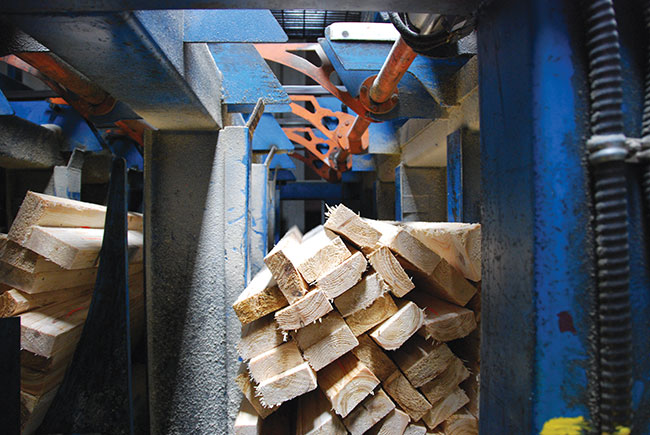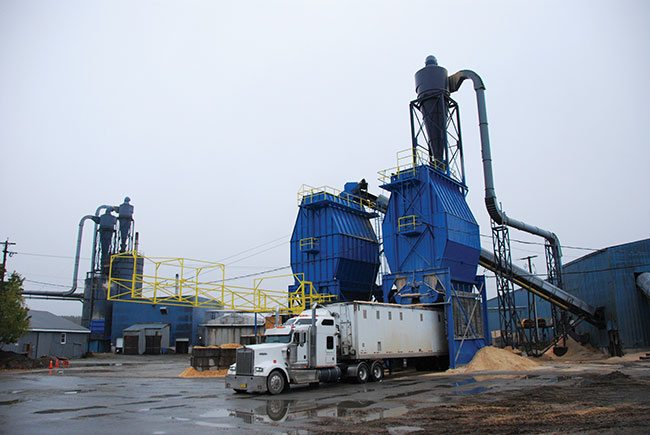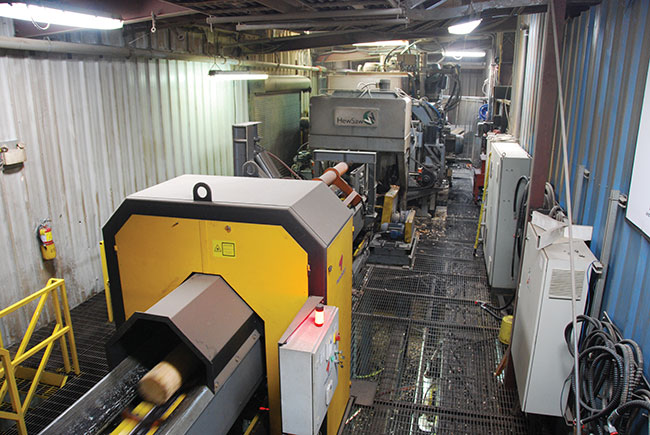
Features
Mills
Sawmilling
75 and going strong: Ledwidge Lumber marks anniversary
January 7, 2019 By Maria Church
 Cassie Turple (right), Ledwidge Lumber’s communications co-ordinator and third generation family member, leads a tour of the mill during an open house last fall in celebration of the company’s 75th anniversary. Photo: Annex Business Media
Cassie Turple (right), Ledwidge Lumber’s communications co-ordinator and third generation family member, leads a tour of the mill during an open house last fall in celebration of the company’s 75th anniversary. Photo: Annex Business Media
Ledwidge Lumber, a family-run spruce and fir stud mill in Enfield, N.S., is accustomed to welcoming guests. In 2008, the mill co-hosted DEMO International, which was the first time the live-logging show took place in Atlantic Canada.
Last fall, Ledwidge once again threw open its doors, this time in celebration of its 75-year anniversary, complete with a community barbeque and sawmill tours.
From a storied past to impressive modern upgrades, the family mill has a lot to show off.
Joining in on a tour with about a dozen community members – a mix of grandparents, parents and children – gave the perfect visual of the sawmill’s key to success. Cassie Turple, communications co-ordinator and third generation family member who led our tour, says community support is hugely important for the family-operated mill.
“We’ve always been a traditional company because we’re family based,” Turple says. “We’re rooted in the community so we recognize how important their involvement is in the company, and how different it can make business for you if people appreciate the fact that you create a business in their community.”
[Editor’s note: Watch a video tour of the sawmill here.]
Determination
The history of Ledwidge Lumber follows the journey of the current owners’ father, Laurie Ledwidge. He established the business in 1943 at 18 years old.
“Through a lot of determination he grew the business over a long period of time. There were two fires that completely burned the mill, and one partially burned it. He basically had to start from scratch twice over that time period, which is quite a feat, really,” Turple says.
Laurie began with a one-man shingle operation and not long after added a long-lumber mill, but the majority of the equipment was lost to the first fire in 1946. Just two years later he started up again with a portable sawmill and 12 employees.
The mill expanded in 1960 with the addition of a six-cylinder diesel engine. Over the next 30 years, the mill burned to the ground twice, once in 1970 and again in 1988. Both times Laurie was able to rebuild and continue sawing. Today the modern mill produces around 70 mmbf a year, and is lovingly run by the second and third generations of Ledwidges.
Laurie Ledwidge passed away in 2013 at 83 years old. “He still came to the office every day and still went to the woods in the afternoons. It was really his passion and his drive that kept the company going. He just picked the rest of us up along the way,” Turple says.
A total of six family members work at the mill. Laurie’s two sons share ownership; Doug Ledwidge serves as president and Jim Ledwidge as vice-president and manager of the woodlands division; he and his wife, Rose, have run a trucking business for over 40 years in partnership with the mill. Kim Fuller, the oldest grandchild, is financial controller. Kyle Ledwidge, the second grandchild, is the heavy equipment manager in woodlands. Turple, the third grandchild, runs communications and her husband, Shawn, is in wood procurement.
“That’s it for family members currently, but we definitely have a lot of employees who are like family. Some have been here for more than 30 years,” Turple says.
Modernizing
A big step forward for the current Ledwidge Lumber mill was the installation of its two HewSaw R200 small log lines, one in 1997 and another in 2007. The older R200 is a smaller batch-fed line that is tooled for a single 2×3 pattern or two 2×4 patterns.
The newer and larger R200 Plus line is scan and set for medium and large logs. A Prologic Plus optimization system allows for the best recovery option to produce larger patterns.
This mill accepts spruce and fir logs between four and 14 inches, which are first treated to Carbotech debarkers. The debarked logs destined for the smaller R200 are then scanned and sorted in four bins. Linden and Comact Wave step feeders feed batches onto conveyors for the smaller line. Logs heading to the larger R200 Plus are sorted into two bins, and are optimized via Prologic Plus.
Lumber from both sawlines are combined via a surge deck, built in-house, and flow into Carbotech unscramblers, followed by a Carbotech grade station with Autolog scanning. The trimmer optimizer was upgraded this past fall by Autolog. The upgrade addressed obsolete optimizer equipment, while utilizing the existing scanner. Despite being a partial upgrade, the mill has already seen a large increase in grade quality. The upgrade has also meant significantly greater confidence in the system’s reliability.
“The project went well,” Ledwidge president Doug says of the upgrade. “There’s been a bit of adjustment as we go and a bit of calibration needed, but the result has been positive.”
After the trimmer, lumber then heads to a bin sorter and stacker, both Carbotech, and then out to one of four kilns: two Wellons double pass track kilns and two COE package style kilns. The COE kilns are high on the list for replacement, Doug says. A Wellons FEI boiler and a KMW boiler fuelled by planer shavings generate heat for the kilns and sawmill in the winter months.
In the planer mill, lumber enters via a Carbotech tilt hoist and is conveyed to an updated Yates planer. Planed lumber passes through an Autolog linear optimization scanner and a Wagner moisture sensor and then flows through a Carbotech grader and trimmer. A Carbotech stacker and Samuel strapping and packaging system finishes the process.
Right now the bottleneck for Ledwidge is fibre supply. The majority of the mill’s wood supply comes from private woodlots. The supplier list is roughly 300 from across the Maritimes.
“Fibre supply is our main hurdle. We’re trying to work with the government on crown land issues to see some more fibre flow our way,” Doug says. Currently just 10 per cent of Ledwidge’s fibre supply is from crown land. The company’s woodlands division manages just over 18,000 acres of land to supply the mill.
Finding solutions
The 2008 recession hit Atlantic Canada’s forest industry hard, and Ledwidge was no exception. “That one really made us tighten our strings in every aspect, and I think from that we’ve become a lot stronger and a lot more efficient,” Turple says.
Out of the dozens of sawmills in Nova Scotia pre-2008, just a handful are still running today.
In order to stay in operation, Ledwidge was forced to make operational cuts to become as lean as possible. They went from a staff of 100 to 80, but have managed to keep the number at 80 ever since. Over the past few years, the mill has fluctuated between single and double shifts, depending on fibre supply.
Hiring skilled workers is a challenge across the Maritimes, and Canada for that matter, but a few key HR strategies are starting to see results for Ledwidge.
“We have a really great employment package now. It’s not all about what you get paid. We’ve also come up with a health and wellness credit for example; so it’s money they can apply to purchase fitness equipment or a gym membership. It’s really about making a holistic package for employees that keeps them here,” Turple says.
Ledwidge also has an apprenticeship program in place. For the past year they’ve had two apprentices working with them under a millwright program and an industrial electrician program.
Turple firmly believes that for Ledwidge to continue operating as a fixture in the community, they need to share their story. The sawmill has an active Facebook page where they post interesting updates from the mill, staff and suppliers, as well as a plan to continue hosting open houses to encourage the community to see what they do first hand.
This emphasis on communications is echoed by the province’s forestry association, which is not surprising given that Turple served eight years with the Forest Nova Scotia executive team, including as the first female president of the association in its 80-year history. During her time there, she was involved in starting up public outreach programs to help share good news about forestry companies in the province.
“I think we need to share our stories today if we’re going to help shape people’s opinion of our industry. It’s a whole level of transparency that people need to see,” Turple says. “The majority of us are family businesses in this province that have been here for generations and we don’t plan on going anywhere. If we have that kind of a long-term outlook, obviously we’re not going to be cutting here today and leaving tomorrow. This is our province, so this is our long-term plan.”
Next 75
Looking to the next 75 years, Ledwidge Lumber has its ear to the ground, listening for market developments that can help propel the family-run company into the future. One example is the recent spike in mass timber and tall wood buildings in North America. At the moment, Atlantic Canada has no mass timber manufacturers.
“There may be a future for us there but it’s hard to say what that will look like for us. It’s a matter of seeing what we want to really dive into,” Turple says. “We’re in a good place right now, but what comes next? I can’t say now, but it’s an exciting thought.”
Print this page



